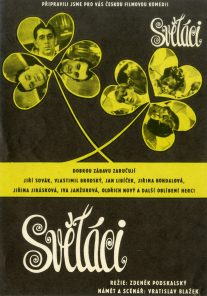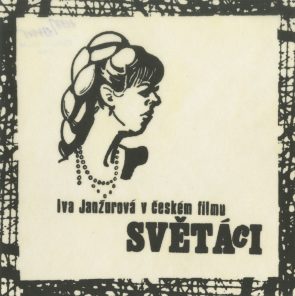“But still, it was nice” – one of the last sentences uttered in the popular musical comedy directed by Zdeněk Podskalský and written by Vratislav Blažek. Three plasterers from the country embody a caricatural cross-section of a society driven by a desire to improve one’s own life. They want to enjoy luxury which is within their reach while working in Prague. Even if it means scamping their work, lying, and cheating on their wives.
Their opening drinking spree, during which they paint the city full of enticing neon lights red begins in a shabby basement bar and ends in a classy establishment which they inadvertently set on fire. They evidently don’t belong in such a place as they only cause trouble. For now. The gentlemen Skopec, Prouza and Petrtýl are not just socially awkward but also persistent and fast learners. Their goal is to blend in with Prague’s high society. It’s the only thing they can talk about.
They move towards their goal with far greater fervour than they have for their duties, which they accept with unconcealed displeasure. Their priorities are different from those of the protagonists of films starring ‘builders of socialism’. The world which they are pulled into is reminiscent of those in comedies and melodramas from the First Czechoslovak Republic. For that matter, the character of a professor emeritus of dance and civics, portrayed by Oldřich Nový, seems as if taken from those very films. Along with their new tailored suits, it is he who should guarantee that the working class will also taste prosperity.
Also the film’s resourceful dialogue, alternating with old Prague folk songs, alludes to the first sound films, whose appeal was enhanced by musical hits. But the choreography of the musical numbers is much closer to those of later musicals. In Men about Town, we see not only the encounters of rich and poor but also a combination of characters and stylistic methods from various periods of Czech cinema. The film spares no one.
The builders of socialism display slyness and small-mindedness. Towards the end of the film, Oldřich Nový’s self-satisfied gentleman, along with a Police Officer, maliciously enjoys how his charges embarrass themselves in a restaurant. Everything he has taught them seems to be a part of his revenge for the time they attacked him after he had asked them to keep quiet in a library. Also the cloakroom attendant Trčková, the widow of a late First Republic banker, acts manipulatively and greedy and steals from the philandering husbands.
But Blažek’s and Podskalský’s criticism aims higher than just to showcase the character flaws of snobs and workers. From the opening scenes with broken neon lights, we see that the environment itself is also deeply flawed. If the protagonists want to fit in, they need to act corruptly. Skopec, Prouza and Petrtýl also need to plaster new façades. Such as the façade of the house in which Trčková runs her underhand business. The glitz distracts from the amoral core and the solutions to problems. Because of their limited life perspectives, the married workers aren’t content and probably never will be. Given the circumstances, they can reach a different social position only with the help of pretence.
In the given system, vertical social mobility is not a real option. The authors see equality, justice, and solidarity as mere mottos which no one in socialist Czechoslovakia even pretends to uphold due to the value orientation of the whole.
Blažek wrote Men about Town in the relaxed atmosphere of the Prague Spring. From the beginning, he had pictured Oldřich Nový as the professor. That’s why his past is conspicuously reminiscent of a First Republic film star career. The production started in Autumn 1968 in the Barrandov Studios. By that time, Blažek had emigrated to Germany. Due to the subsequent changes in the management of Czechoslovak film, it premiered almost a year later.
The rumour that the film combining a Pygmalionesque motif with a class satire ended up in storage is therefore not true. On the contrary, almost three million people attended the film, and it became the biggest hit of 1969. In addition to the film’s rhythm and biting dialogues, a huge share of the success can be attributed to its star-studded cast. Jiří Sovák, Vlastimil Brodský and Jan Libíček excel as the plasterers. Their female counterparts, caricatures of coquettish easy women, are portrayed by Jiřina Jirásková, Iva Janžurová and Jiřina Bohdalová. Some of Sovák’s ideas were even incorporated into the script, and the actors had a chance to improve their performances by improvising, which affected the cinematography. In longer wide shots, cinematographer František Valerta usually includes at least three actors at once. In addition to dialogues, the dynamics of these static shots with high depth of field are increased by the characters’ movement in the space. Their position changes along with their roles in the dialogue. Even though the alternation between front and back planes, edges and centres may seem spontaneous, a careful observer notices a similar level of intentionality as is present in the choreography of musical numbers.
The sentences flow as our attention is directed from one speaker to another. In the best scenes, the events unfold in multiple planes simultaneously. During the final encounter, Petrtýl, in the front, clumsily tries to use a fork while Prouza, in the back, babbles about UFOs. In this concept, it’s hardly ever necessary to cut to a detail. If it happens, the detail usually brings a new input to a conversation or represents a punchline. For instance, in the scene in which we cut to a portrait on the wall to see that it’s not the late husband of the widowed cloakroom attendant as Petrtýl assumes but Czech composer Bedřich Smetana.
After the film introduces the protagonists in a sequence of loosely linked humorous scenes built on the parallels between the trios of male and female characters, it escalates with a final encounter. The three hicks assume that they have the honour of spending time with three emancipated Prague intellectuals. But in reality, they are meeting a former model and a cleaning lady. They try to charm each other with some random memorised facts about literature, painting and astrophysics. They tend to drop their acts, garble the learned phrases and their cyclical conversations lead nowhere.
“Nothing that is alien is human to us,” says Skopec confidently. The ladies, who also just pretend to be erudite, don’t notice a thing. In a society focusing on quickly satisfying one’s needs instead of deeper comprehension (regardless of what or whom), the substance of the words and one’s personality aren’t important. Instead, it’s what people project outwards and how well they are versed in social deceit that counts. For their deceitfulness, superficiality, and self-interest, all six unfortunate souls pay with broken limbs, but the sentence quoted at the beginning giving the humorous spectacle a bitter end doesn’t indicate that they have learned a lesson and understood that this is not the way to find happiness.
Martin Šrajer




